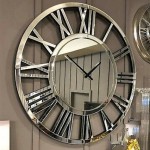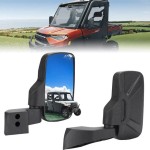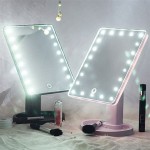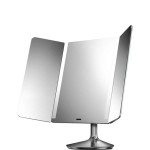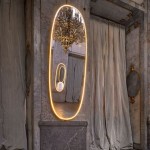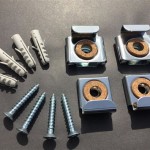The Enduring Appeal and Practical Applications of Full-Length Wall Mirrors
Full-length wall mirrors represent more than simply reflective surfaces; they are integral elements of interior design, practical tools for self-assessment, and potential enhancers of perceived space within a room. Their ubiquity across various settings, from residential bedrooms to commercial retail spaces, underscores their versatility and enduring appeal. Understanding the diverse applications, design considerations, and installation techniques associated with full-length wall mirrors is crucial for both selecting the appropriate mirror and maximizing its potential benefits.
The history of mirrors dates back millennia, with early examples crafted from polished obsidian or metal. The invention of glass mirrors, backed with reflective metallic coatings, marked a significant turning point, making mirrors more accessible and affordable. The evolution of mirror manufacturing processes has led to advancements in clarity, durability, and design options, culminating in the wide array of full-length wall mirrors available today. Modern full-length wall mirrors often incorporate safety features like shatter-resistant glass and diverse frame styles to complement various aesthetic preferences.
Enhancing Space and Light: Perceptual Effects
One of the primary reasons individuals and designers incorporate full-length wall mirrors into interior spaces is their ability to manipulate perception. Mirrors create the illusion of greater depth, particularly in smaller rooms. By reflecting light, they brighten dimly lit areas and contribute to a more open and airy atmosphere. The strategic placement of a full-length mirror can effectively double the perceived size of a room, making it feel less cramped or confined. This is particularly beneficial in apartments, hallways, and other areas where square footage is limited.
The location of the mirror plays a critical role in achieving the desired effect. Positioning a full-length mirror opposite a window allows it to capture and reflect natural light, maximizing illumination throughout the space. Placing it on a wall adjacent to a doorway can visually lengthen a hallway, creating a more inviting entrance. In bedrooms, mirrors are frequently positioned near dressing areas to facilitate outfit selection and self-assessment. The angle at which the mirror is hung or leaned against the wall also influences the reflection and the overall impact on the room's perceived dimensions.
Beyond simply reflecting light, full-length mirrors can also be used to accentuate existing architectural features or design elements. For example, placing a mirror near a piece of art or a decorative plant can amplify its visual impact and draw attention to the focal point. Mirrors can also be used to reflect and emphasize a particular color scheme or pattern, creating a more cohesive and visually appealing interior. The effectiveness of this technique depends on careful consideration of the surrounding environment and the intended artistic effect.
Functional Applications: Personal Grooming and Self-Assessment
Beyond their decorative and spatial enhancement capabilities, full-length wall mirrors serve a crucial functional purpose: facilitating personal grooming and self-assessment. Having a clear, undistorted reflection of one's entire body allows individuals to accurately assess their appearance, ensuring proper attire, grooming, and overall presentation. This is particularly important for individuals in professions that require a polished and professional image.
The size and placement of the mirror are critical for optimal functionality. A mirror that is too narrow may not provide a complete view of the body, hindering effective outfit assessment. Similarly, a mirror that is positioned too high or too low may require awkward postures to achieve a full view. The ideal height and width will vary depending on the individual user's height and the intended usage of the mirror. Ergonomics should be carefully considered when selecting and installing a full-length wall mirror.
Lighting also plays a significant role in the functional effectiveness of a full-length mirror. Insufficient or poorly positioned lighting can cast shadows and distort the reflection, making it difficult to accurately assess one's appearance. Ideally, the area around the mirror should be well-lit with a combination of ambient and task lighting. Sconces or vanity lights positioned on either side of the mirror can provide even illumination and minimize shadows. The color temperature of the lighting should also be considered; a natural, balanced light source is generally preferred for accurate color representation.
Design and Installation Considerations: Aesthetic and Safety
Selecting a full-length wall mirror involves careful consideration of design aesthetics and installation safety. The frame style, size, and mounting method should complement the existing décor and architectural style of the room. Safety is paramount, especially in homes with children or pets. The mirror should be securely mounted to the wall to prevent accidental falls, and shatter-resistant glass should be considered to minimize the risk of injury in the event of breakage.
Frame styles range from ornate and traditional to sleek and modern, offering a wide variety of options to suit different tastes. Wooden frames add warmth and character, while metal frames provide a more contemporary and minimalist look. Frameless mirrors offer a clean and seamless aesthetic, blending seamlessly into the surrounding environment. The choice of frame style should be guided by the overall design theme of the room and the desired visual impact.
Installation methods vary depending on the type of mirror and the wall construction. Mirrors can be hung using heavy-duty hooks and wires, mounted directly to the wall using adhesive or screws, or leaned against the wall for a more casual look. Proper installation is crucial to ensure the mirror is securely attached and remains stable over time. It is recommended to consult with a professional installer if you are unsure about the proper mounting techniques or if the wall construction is particularly challenging. For leaned mirrors, anti-tip hardware should be added to further prevent the mirror from falling.
Safety features such as shatter-resistant glass are particularly important in high-traffic areas or in homes with young children. Shatter-resistant glass is designed to break into small, blunt fragments rather than sharp shards, minimizing the risk of injury. This type of glass is readily available and is a worthwhile investment for enhanced safety. Furthermore, the edges of the mirror should be smooth and polished to prevent cuts or abrasions.

17 5 X 49 Calter Full Length Wall Mirror Gold Kate And Laurel Target

12 Best Full Length Mirrors 2024 Affordable Long

17 5 X 49 Calter Full Length Wall Mirror White Kate And Laurel Target

Xramfy 48 In H X 14 W Modern Rectangular Gold Aluminum Alloy Framed Full Length Mirror Wall Wm1448 The Home Depot

Full Length Wall Mirror Wood Square Mosaic Design Frame

Extra Large Ornate White Wall Floor Leaner Full Length Mirror 100cm X 200cm Flora Furniture

Full Length Mirror Door Hanging Wall With Rectangular Float Framed Explosion Proof Mounted Make Up Vanity For Bedroom Entryway 50 X 14 Gold Com

Homestock 66 H X 32 W Silver Full Length Mirror For Home Bedroom Large Wall Floor 98822 The Depot

Neutype 15 7 In W X 55 H Black Framed Full Length Wall Mirror At Com

17 5 X 49 Calder Full Length Wall Mirror Gold Kate Laurel All Things Decor Target
